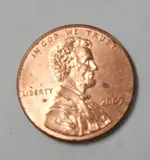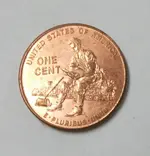It gave a dull thunk with a ding. I think the ding was the copper coating.
Hmmm, very interesting. I think what you need to do is have a friend drop the coin from a height such that when it hits the ground it will have achieved terminal velocity. That will give off the true sound. Make sure you calculate wind resistance, humidity, and barometric pressure as variables. In case you forgot gravity accelerates at 9.8 meters per second squared.
Mathematically, terminal velocity—without considering buoyancy effects—is given by
V_t= \sqrt{\frac{2mg}{\rho A C_d }}
where
V_t is terminal velocity,
m is the mass of the falling object,
g is the acceleration due to gravity,
C_d is the drag coefficient,
\rho is the density of the fluid through which the object is falling, and
A is the projected area of the object.
In reality, an object approaches its terminal velocity asymptotically.
Buoyancy effects, due to the upward force on the object by the surrounding fluid, can be taken into account using Archimedes' principle: the mass m has to be reduced by the displaced fluid mass \rho\mathcal{V}, with \mathcal{V} the volume of the object. So instead of m use the reduced mass m_r=m-\rho\mathcal{V} in this and subsequent formulas.
On Earth, the terminal velocity of an object changes due to the properties of the fluid, the mass of the object and its projected cross-sectional surface area.
Air density increases with decreasing altitude, ca. 1% per 80 metres (260 ft) (see barometric formula). For objects falling through the atmosphere, for every 160 metres (520 ft) of falling, the terminal velocity decreases 1%. After reaching the local terminal velocity, while continuing the fall, speed decreases to change with the local terminal velocity.
Derivation for terminal velocity
Mathematically, defining down to be positive, the net force acting on an object falling near the surface of Earth is (according to the drag equation):
F_{net} = m a = m g - {1 \over 2} \rho v^2 A C_\mathrm{d}
At equilibrium, the net force is zero (F = 0);
m g - {1 \over 2} \rho v^2 A C_\mathrm{d} = 0
Solving for v yields
v = \sqrt\frac{2mg}{\rho A C_\mathrm{d}}
I am positive this will yield the true nature of the gold and not harm the coin in any way.









